What can you do教学设计
What Can You Do英语教案及反思

What Can You Do 英语教案及反思第一章:教学目标与内容1.1 教学目标让学生能够理解和运用目标句型"What can you do?" 进行询问和回答。
让学生能够介绍自己的能力和喜好。
提高学生的听说读写综合语言运用能力。
1.2 教学内容引入新的词汇:like, play, read, write, draw, listen to music 等。
目标句型:What can you do? I can play basketball/read books/draw pictures, etc.第二章:教学步骤2.1 热身活动(5分钟)引导学生进行简单的自我介绍,例如:Hello, my name is Tom. I am 12 years old.引导学生进行简单的活动,例如:Can you clap your hands? Can you jump?2.2 引入新词汇(10分钟)展示图片,引导学生说出对应的动作或喜好,例如:I like playing soccer.引导学生模仿动作,并重复句子。
2.3 学习目标句型(10分钟)展示目标句型"What can you do?" 的图片,引导学生模仿发音。
引导学生进行角色扮演,例如:A: What can you do? B: I can sing songs. 2.4 小组活动(10分钟)将学生分成小组,每组选择一个队长。
队长回答"What can you do?" 的问题,其他队员进行相应的动作。
引导学生回顾目标句型和词汇。
布置作业:用目标句型和词汇编写一段对话。
第三章:教学反思3.1 教学效果学生能够理解和运用目标句型进行询问和回答。
学生能够介绍自己的能力和喜好。
学生的听说读写综合语言运用能力得到提高。
3.2 教学改进在教学过程中,注重引导学生模仿发音,提高口语表达能力。
《What Can You Do》教案模板

《What Can You Do》教案模板一个好的教学设计是一节课成败的关键,要根据不同的课题进行灵敏的教学设计。
首先对每一个课题的教学内容要有一个整体的把握。
下面就是我给大家带来的《What Can You Do》教案,希望能关怀到大家!《What Can You Do》教案(一)教学目标1. 能听、说、认读单词“learn”,“any”,“problem”和词组“no problem”。
2. 能听懂、会说句子“Can I ?”进行问答练习。
3. 能完成“Lets try”部分的听力任务。
4. 提高学生自主学习、主动学习的意识和与他人进行沟通、沟通的能力,让学生感受到合作学习的乐趣和效率。
教学重难点1. 能听、说、认读单词“learn”,“any”,“problem”和词组“no problem”。
2. 能听懂、会说句子“Can I ?”进行问答练习。
教学难点词组“no problem”的使用。
教学过程一、课前热身(Warm-up)1. Free talkT: Good morning, everyone. Nice to meet you.Ss: Good morning, teacher. Nice to see you, too.T: How are you today?Ss: Very well, thanks.T: What can you do, S1?S1: I canT: Can you ?S2: Yes, I can. / No, I cant.2. 教师播放Lets chant的录音,全班学生跟着录音吟唱并做动作。
Dog, dog, can you run?Yes, I can . Yes, I can .Panda, panda, can you swim?No, I cant. No, I cant.Sarah, Sarah, can you dance?Yes, I can . Yes, I can .Mike, Mike, can you cook?No, I cant. No, I cant.二、课前预习(Preview)1. 教师表演,学生说出相应的单词或词组,复习上节课学习的词汇。
《WHAT CAN YOU DO 》 教学设计

《WHAT CAN YOU DO 》教学设计《<WHAT CAN YOU DO> 教学设计》一、教学目标1、知识目标学生能够听懂、认读并理解与日常活动相关的动词短语,如“sweep the floor”“cook the meals”“water the flowers”等。
学生能够运用句型“What can you do? I can”来询问和表达自己能够做的事情。
2、能力目标培养学生的听、说、读、写综合语言运用能力,使学生能够在实际情境中运用所学句型进行交流。
提高学生的语言思维能力和创新能力,能够根据所学内容进行拓展和发挥。
3、情感目标激发学生学习英语的兴趣,增强自信心,培养合作精神和自主学习能力。
引导学生认识到自己的能力和价值,鼓励他们积极参与家务劳动和社会实践。
二、教学重难点1、教学重点掌握重点动词短语的发音和意义,以及句型“What can you do? I can”的正确运用。
2、教学难点能够灵活运用所学句型和短语进行真实情境下的交流,并且注意动词短语的形式变化。
三、教学方法1、情景教学法通过创设生动有趣的生活情景,让学生在实际情境中学习和运用语言,增强学习的趣味性和实用性。
2、任务驱动法布置各种任务,如小组讨论、角色扮演等,让学生在完成任务的过程中提高语言运用能力和合作能力。
3、游戏教学法通过设计有趣的游戏,如猜单词、接龙等,激发学生的学习兴趣,巩固所学知识。
四、教学过程1、导入(Warming up)通过播放一首欢快的英语歌曲“What Can You Do?”,让学生在轻松愉快的氛围中进入课堂。
歌曲结束后,提问学生:“What can you hearin the song?”引导学生回忆歌曲中提到的活动,从而引出本节课的主题。
2、呈现(Presentation)(1)利用多媒体展示一些与家务劳动相关的图片,如扫地、做饭、浇花等,一边展示一边教学生相应的动词短语:“sweep the floor”“cook the meals”“water the flowers”等。
教学设计what can you do
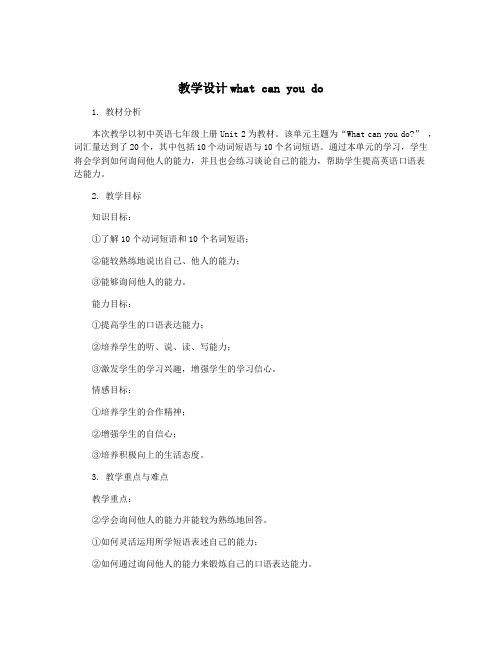
教学设计what can you do1. 教材分析本次教学以初中英语七年级上册Unit 2为教材。
该单元主题为“What can you do?” ,词汇量达到了20个,其中包括10个动词短语与10个名词短语。
通过本单元的学习,学生将会学到如何询问他人的能力,并且也会练习谈论自己的能力,帮助学生提高英语口语表达能力。
2. 教学目标知识目标:①了解10个动词短语和10个名词短语;②能较熟练地说出自己、他人的能力;③能够询问他人的能力。
能力目标:①提高学生的口语表达能力;②培养学生的听、说、读、写能力;③激发学生的学习兴趣,增强学生的学习信心。
情感目标:①培养学生的合作精神;②增强学生的自信心;③培养积极向上的生活态度。
3. 教学重点与难点教学重点:②学会询问他人的能力并能较为熟练地回答。
①如何灵活运用所学短语表述自己的能力;②如何通过询问他人的能力来锻炼自己的口语表达能力。
4. 教学方法本次教学采用任务型教学法、情境教学法、合作学习法、评价反馈法等多种教学方法,既注重教师的引导与指导,又充分发挥学生的主动性和创造性。
5. 教学过程设计(一)引入新课1. Greet students and check homework.3. Ask the students questions:“Do you know any famous people? What can they do?”“Today we are going to learn more about skills and abilities. We will learn how to talk about our own skills and ask others about theirs.”(二)学习新知“What is he/she good at?”(三)巩固练习(四)合作学习(五)展示评价(六)作业布置6. 教具准备电脑,投影仪,PPT,录音机,黑板,笔等。
小学英语《What can you do》优质课教学设计、教案
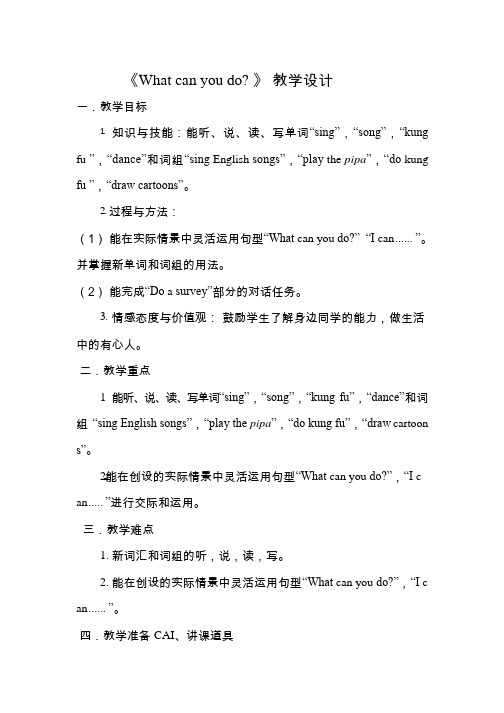
《What can you do? 》教学设计一.教学目标1.知识与技能:能听、说、读、写单词“sing”,“song”,“kung fu ”,“dance”和词组“sing English songs”,“play the pipa”,“do kung fu ”,“draw cartoons”。
2.过程与方法:(1)能在实际情景中灵活运用句型“What can you do?”“I can ...... ”。
并掌握新单词和词组的用法。
(2)能完成“Do a survey”部分的对话任务。
3.情感态度与价值观:鼓励学生了解身边同学的能力,做生活中的有心人。
二.教学重点1.能听、说、读、写单词“sing”,“song”,“kung fu”,“dance”和词组“sing English songs”,“play the pipa”,“do kung fu”,“draw cartoon s”。
2...能在创设的实际情景中灵活运用句型“What can you do?”,“I c an ..... ”进行交际和运用。
三.教学难点1.新词汇和词组的听,说,读,写。
2.能在创设的实际情景中灵活运用句型“What can you do?”,“I c an ...... ”。
四.教学准备CAI、讲课道具五.教学过程Step1 .Warm-up and lead-in(1)Greetings: Hello,boys and girls. Are you ready? OK, please give me a big smile.(2)Let’s doT:Look, what’s the weather like today? It’s cold, so let’s do, OK! Follow me, stand up , shake your body, clap your hands, sit down please!T:You see, I can stand up, I can clap hands, I can shake body, I can clap hands. I can do many things. I am wonderful. Now I let’s watch a video and try to answer “ What can Miss wu do in the video?”,请学生一起观看视频,通过视频找到答案,让学生初步整体感知本节课所教授的新知。
《Unit 4 What Can You Do》教学设计
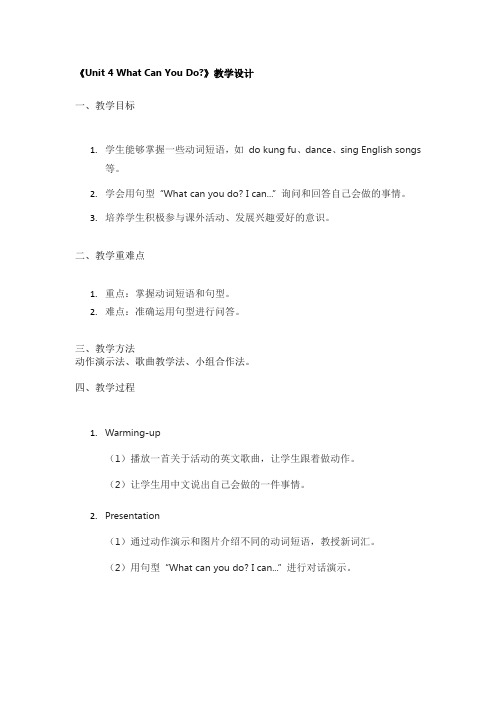
《Unit4What Can You Do?》教学设计
一、教学目标
1.学生能够掌握一些动词短语,如do kung fu、dance、sing English songs
等。
2.学会用句型“What can you do?I can...”询问和回答自己会做的事情。
3.培养学生积极参与课外活动、发展兴趣爱好的意识。
二、教学重难点
1.重点:掌握动词短语和句型。
2.难点:准确运用句型进行问答。
三、教学方法
动作演示法、歌曲教学法、小组合作法。
四、教学过程
1.Warming-up
(1)播放一首关于活动的英文歌曲,让学生跟着做动作。
(2)让学生用中文说出自己会做的一件事情。
2.Presentation
(1)通过动作演示和图片介绍不同的动词短语,教授新词汇。
(2)用句型“What can you do?I can...”进行对话演示。
3.Practice
(1)动作模仿游戏:一名学生做动作,其他学生用英语猜出动作名称。
(2)句型练习:小组活动,互相询问会做的事情并回答。
4.Production
(1)让学生制作自己的才艺展示海报,用英语写上自己会做的事情和特长。
(2)展示学生的海报,进行交流分享。
5.Summary and Homework
(1)总结词汇和句型。
(2)作业:用英语写一篇关于自己才艺的短文。
Unit4WhatcanyoudopartB(教学设计)人教PEP版英语五年级上册

课件、单词卡片
教学过程
批注
Step 1 Warmup& Revision
歌曲导入,激发学生学习的兴趣。热身活动复习旧知,为新知学习作铺垫。
1.Greetings.
2.Let’s sing:What can you do?
3.Let’s do and say.
’s learn部分的图片,学生看图片说出有关课余文化活动的单词或词组,同时做相应的动作。
1.小结:师生共同回顾本节课所学重点单词、短语及句型。
2.作业。
(1)熟读并背诵本课时词汇。
(2)完成本课时配套练习。
板书设计
Unit 4 What can you do?
第四课时
—Can you swim/ speak English/ cook/ play basketball/ play pingpong?
T:Can you do any kung fu? Ss:Yes, I can. / No, I can’t.
(2)引入Let’s try部分的听力活动。
教师根据上一环节的活动,提出问题:Can Mike do any kung fu?
A.教师播放第一遍音频,让学生听关键信息如“It’s kung fu today. It’s cool but I can’t do it.”
2.能力目标:学生能够综合运用本单元句型和核心词汇描述自己会和不会的事情。
3.情感目标:能够乐于表达并和他人分享各自会和不会的事情。
教学重点
掌握有关课余文化活动的五个单词或词组;掌握句型“Can you…?”及其答语“Yes, I can. / No, I can’t.”
教学难点
部分单词或词组的认读和拼写,如:pingpong,basketball等。
what can you do教学设计

教学目标:【认知目标】1.能够听、说、读、认单词和短语:want,send,email2.能够正确理解并按照正确的意群及语言、语调跟读Robin找朋友的电子邮件。
3.能够正确地表达自己的会做的事情和不会做的事情。
【能力目标】1.能掌握基本的阅读策略,利用所学阅读策略获取文章主要情节信息。
2.能在老师的帮助下对文章的主要情节进行归纳和复述,并完成回信。
【情感目标】正确认识自我,找到志趣相投的朋友。
【现代教学手段】多媒体课件视频。
3.教学重点与难点:【教学重点】1.能够读懂电子邮件,找出关键信息,完成读后任务。
2.能够综合运用本单元的核心词句,并参考范例,完成个性化书写。
【教学难点】学生能够建立起关键词组和相关事件的联系,提高阅读效率,培养阅读的自信心,同时渗透阅读策略。
二、教学准备教师以课标为依据,参考教师用书及多种教辅进行教案和多媒体课件设计;将教室座位调节成四人小组的形式,有利于小组活动实施,采用情景教学法创设大家接收Robin邮件的情景和课堂氛围;要求学生复习上教版1A 中Unit3 My abilities和1B中Unit3 Things I like to do的重点句型I can…的运用,为学习新知打下基础。
三、教学过程Step I Warming-up (热身)1.Sing a song:What can you do?【设计意图:课前通过与学生一起唱本单元歌曲,活跃学习氛围,并直接切入本课主题。
】2. Greetings T: Hello,I’m Heidi. I am friendly and kind. I can sing English songs and speak English. I like playing games. Do you like playing games? Ss:Yes! T: Let’s play together.3. Let’s play To make a sentence with CAN or CAN’T as quickly as you can. 【设计意图:教师通过自我介绍,引出单元重点句型,并利用游戏的形式复习单词,提高学生学习的积极性,为进一步学习进行了铺垫。
What can you do小学五年级英语教案
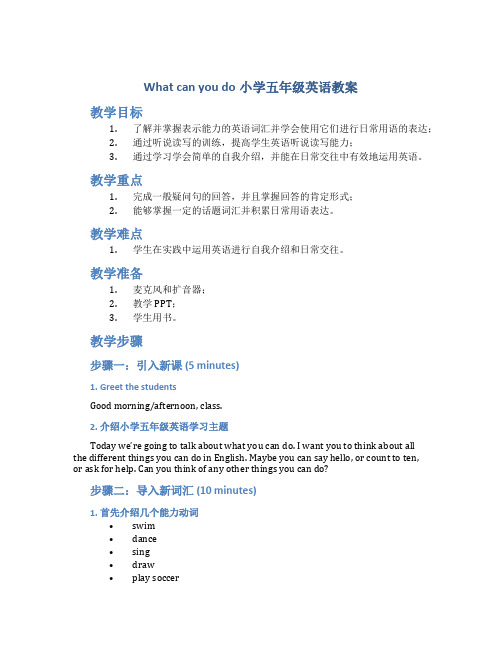
What can you do小学五年级英语教案教学目标1.了解并掌握表示能力的英语词汇并学会使用它们进行日常用语的表达;2.通过听说读写的训练,提高学生英语听说读写能力;3.通过学习学会简单的自我介绍,并能在日常交往中有效地运用英语。
教学重点1.完成一般疑问句的回答,并且掌握回答的肯定形式;2.能够掌握一定的话题词汇并积累日常用语表达。
教学难点1.学生在实践中运用英语进行自我介绍和日常交往。
教学准备1.麦克风和扩音器;2.教学PPT;3.学生用书。
教学步骤步骤一:引入新课 (5 minutes)1. Greet the studentsGood morning/afternoon, class.2. 介绍小学五年级英语学习主题Today we’re going to talk about what you can do. I want you to think about allthe different things you can do in English. Maybe you can say hello, or count to ten,or ask for help. Can you think of any other things you can do?步骤二:导入新词汇 (10 minutes)1. 首先介绍几个能力动词•swim•dance•sing•draw•play soccer2. 向学生展示新单词的图片例子并连读单词让学生跟读和模仿老师的发音。
步骤三:听写 (10 minutes)1. 让学生熟读所学过的能力动词swim, dance, sing, draw, play soccer2. 让学生熟悉各个单词的拼写教师给每个单词读出来并让学生在纸上写下单词的拼写。
步骤四:学生自我介绍 (20 minutes)1. 让学生互相介绍自己并使用所学过的能力动词教师示范:My name is John. I can swim and play soccer. What about you?2. 老师引导学生进行第一轮自我介绍教师展示自己的自我介绍并让学生模仿。
Unit4 What can you do?Part A Let’s talk(教学设计)人教PEP

Unit4 What can you do?Part A Let’s talk(教学设计)1. 教学目标1.学生能够听、说、读、写本单元的重点短语和句子。
2.能够根据问题回答自己的能力和特长。
3.能够在日常生活中运用所学句型进行交流。
2. 教学重点1.学生能够理解并正确运用本单元的短语和句型。
2.能够对自己的能力和特长有所了解。
3. 教学准备1.教材:人教PEP版英语五年级上册。
2.手机、电脑、投影仪等教学设备。
3.活动道具:实物和图片等,如球、笔、纸张等。
4. 教学过程4.1 自主学习•通过老师设计的多媒体教学方式,让学生学习本单元的对话,并完成该单元的相关练习和作业。
•学生需通过学习获取以下短语和句型:What can you do? I can + 动词原形。
4.2 合作学习•将学生分为小组,让他们根据学生自己的特长和能力,编写一个短对话,要求这个对话包含在本单元中所学的短语和句型。
•学生需要完成书面记录并讲述自编对话。
同时也需要听同组成员的讲述,然后进行互动讨论,提出自己的看法和意见。
•这项合作学习活动可以让学生更好地实际运用所学句型,以及进一步加深他们对所学内容的理解。
4.3 大合唱活动•请学生轮流报出自己擅长的事情,跟随老师的指挥,以集体唱歌的方式把自己擅长的事情表现出来。
•该活动将提高学生的口语表达能力,并通过学习、分享和互动,让学生更好地认识自己的特长和能力。
5. 教学作业1.学生需要完成当堂课学习的相关练习。
2.学生需要完成老师布置的口头表达作业,即当堂课所学的“大合唱”活动。
6. 总结•通过该课的教学设计,学生可以夸展自己的能力,提高英语口语的表达能力。
•通过小组合作与互动的方式,还可以促进学生之间的交流和合作,进一步提高他们的社交能力。
Unit 4 What Can You Do- 教学设计

Unit 4 What Can You Do? 教学设计Unit 4 What Can You Do? 教学设计一、教学内容A Let’s talk _ Group Work二、教学目标1. 知识目标:听懂、会说:Are you helpful at home? What can you do? I can...2. 能力目标:能在实际情景中灵活运用所学句子。
3. 情感目标:培养学生热爱劳动、乐于助人的优秀品质。
三、教学重点Are you helpful at home? What can you do? I can...四、教学难点本课重点句型在实际情景中的运用。
五.课前准备配套录音磁带、单词卡片、劳动工具图片及多媒体课件。
六、教学过程ProcedureMethodPurposePre-task1. Let’s chant教师放歌谣录音,学生模仿各种动物边做动作边说唱歌谣。
歌谣结束时,教师拿出sweep the floor的卡片,问一名学生: ..., what can you do? 引到该生回答: I can sweep the floor.2. Let’s play游戏:心有灵犀两名学生上台,其中一人根据教师出示的卡片(A部分Let’s learn中所学词组)做动作,另一人根据动作说出相应的词组。
如果时间允许,可以请几组学生上台,猜词最快最多的一组为获胜组。
3. 新知呈现a. 教师利用PPT介绍:This is Chen Jie. She can do many things. She is helpful at home. Are you helpful at home? 引导学生回答。
(编辑注:由于没有PPT内容的介绍,仅从现有文字看,新知呈现部分设计显得单薄。
)b. 教师说:Oh, you are helpful at home. What can you do? 引导学生用 I can... 结构作答并适时做出评价。
Whatcanyoudo设计 -完整版教学设计
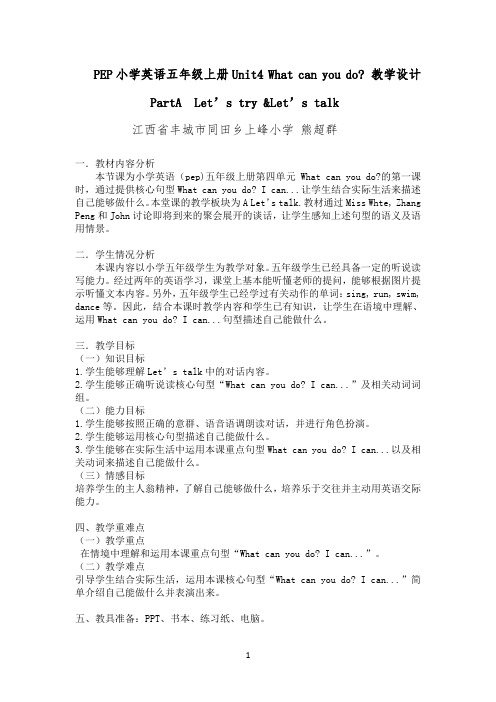
PEP小学英语五年级上册Unit4What can you do? 教学设计PartA Let’s try &Let’s talk江西省丰城市同田乡上峰小学熊超群一.教材内容分析本节课为小学英语(pep)五年级上册第四单元What can you do?的第一课时,通过提供核心句型What can you do? I can...让学生结合实际生活来描述自己能够做什么。
本堂课的教学板块为A Let’s talk.教材通过Miss Whte, Zhang Peng和John讨论即将到来的聚会展开的谈话,让学生感知上述句型的语义及语用情景。
二.学生情况分析本课内容以小学五年级学生为教学对象。
五年级学生已经具备一定的听说读写能力。
经过两年的英语学习,课堂上基本能听懂老师的提问,能够根据图片提示听懂文本内容。
另外,五年级学生已经学过有关动作的单词:sing, run, swim, dance等。
因此,结合本课时教学内容和学生已有知识,让学生在语境中理解、运用What can you do? I can...句型描述自己能做什么。
三.教学目标(一)知识目标1.学生能够理解Let’s talk中的对话内容。
2.学生能够正确听说读核心句型“What can you do? I can...”及相关动词词组。
(二)能力目标1.学生能够按照正确的意群、语音语调朗读对话,并进行角色扮演。
2.学生能够运用核心句型描述自己能做什么。
3.学生能够在实际生活中运用本课重点句型What can you do? I can...以及相关动词来描述自己能做什么。
(三)情感目标培养学生的主人翁精神,了解自己能够做什么,培养乐于交往并主动用英语交际能力。
四、教学重难点(一)教学重点在情境中理解和运用本课重点句型“What can you do? I can...”。
(二)教学难点引导学生结合实际生活,运用本课核心句型“What can you do? I can...”简单介绍自己能做什么并表演出来。
人教版(PEP)英语五年级上册《Unit 5 What can you do 》教学设计

人教版(PEP)英语五年级上册《Unit 5 What can you do 》教学设计一. 教材分析《PEP》英语五年级上册《Unit 5 What can you do》主要围绕“询问和介绍能力”这一主题展开。
通过本节课的学习,学生能够掌握询问他人能力和介绍自己能力的基本句型,如“What can you do?”, “I can swim/dance/sing.”等,并能够运用所学知识进行简单的日常交流。
二. 学情分析五年级的学生已经具备一定的英语基础知识,对日常英语交流有一定的了解。
但部分学生可能在口语表达和听力理解方面还存在一定的困难。
因此,在教学过程中,需要关注学生的个体差异,合理安排教学内容,调动学生的学习积极性。
三. 教学目标1.知识目标:学生能够掌握询问他人能力和介绍自己能力的基本句型,如“What can you do?”, “I can swim/dance/sing.”等。
2.能力目标:学生能够在日常生活中运用所学知识进行简单的交流。
3.情感目标:通过小组合作、互动交流,培养学生的团队协作能力和自信心。
四. 教学重难点1.重点:掌握询问他人能力和介绍自己能力的基本句型。
2.难点:正确运用所学知识进行日常交流,尤其是听力理解和口语表达。
五. 教学方法采用情境教学法、交际法、任务型教学法和小组合作学习法等。
通过创设真实、有趣的情境,引导学生主动参与课堂活动,提高学生的口语表达和听力理解能力。
六. 教学准备1.教学课件:制作含有动画、图片、文字等多媒体课件。
2.教学卡片:准备用于操练和游戏的活动卡片。
3.教学录音:准备与本节课内容相关的听力材料。
4.课堂活动用具:如贴纸、彩笔等。
七. 教学过程1.导入(5分钟)利用多媒体课件展示本节课的主题,引导学生谈论自己喜欢的事物。
如:“Hello, boys and girls. Let’s talk about our hobbies. What do you like?”2.呈现(10分钟)通过课件展示本节课的主要句型“What can you do?”, “I can swim/dance/sing.”等,并用动画人物进行演示。
人教PEP版英语五上《Unit4WhatCanYouDo》教案

人教PEP版英语五上《Unit 4 What Can You Do》教案一. 教材分析《Unit 4 What Can You Do》是人教PEP版英语五上的一个单元,主题是询问和介绍人们的本领。
本单元的主要内容包括动词短语的掌握,如“swim, play the guitar, dance, draw”等,以及如何用“What can you do? I can…”进行询问和回答。
本节课的内容与学生的日常生活紧密相连,有利于激发他们的学习兴趣和参与度。
二. 学情分析五年级的学生已经掌握了基本的英语语法和词汇,具备一定的听说读写能力。
他们在学习过程中善于模仿和重复,对于新鲜有趣的活动充满热情。
但部分学生可能在口语表达上还存在困难,需要教师耐心引导和鼓励。
三. 教学目标1.知识目标:学生能够掌握动词短语“swim, play the guitar, dance, draw”等,并能用“What can you do? I can…”进行询问和回答。
2.能力目标:学生能够在日常生活中运用所学知识进行交流,提高口语表达能力。
3.情感目标:培养学生热爱生活,勇于展示自己的本领。
四. 教学重难点1.重点:动词短语“swim, play the guitar, dance, draw”的掌握和运用。
2.难点:能够用“What can you do? I can…”进行询问和回答。
五. 教学方法1.任务型教学法:通过设定各种真实场景的任务,让学生在完成任务的过程中运用所学知识。
2.情境教学法:创设生动有趣的情境,激发学生的学习兴趣和参与度。
3.分组合作学习:鼓励学生分组进行讨论和练习,提高他们的团队协作能力。
六. 教学准备1.教学课件:制作含有图片、动画和游戏的课件,吸引学生的注意力。
2.实物道具:准备一些与动词短语相关的实物道具,如游泳圈、吉他等,帮助学生更好地理解和记忆。
3.作业本:准备一些练习题,用于巩固所学知识。
- 1、下载文档前请自行甄别文档内容的完整性,平台不提供额外的编辑、内容补充、找答案等附加服务。
- 2、"仅部分预览"的文档,不可在线预览部分如存在完整性等问题,可反馈申请退款(可完整预览的文档不适用该条件!)。
- 3、如文档侵犯您的权益,请联系客服反馈,我们会尽快为您处理(人工客服工作时间:9:00-18:30)。
Part B Unit 4 of PEP Primary English Book for Grade FiveWhat can you do?Period 4 教学设计荆门市东宝区教学研究室廖士新I Teaching contents(教材分析):本课时是PEP Primary English五年级上册第四单元第四课时的内容,课文以图文并茂的形式呈现了五个有关家务劳动的词组、一个交际句型和一段chant。
与生活贴近,具有较强的交际性。
II Students analysis(学情分析):本课时的教学对象是五年级的学生,他们已经学过两年的英语,有一定的听、说、读、写能力,能就自己喜爱的话题提出相应的问题,能够积极的进行自主学习、合作学习完成学习任务。
III Teaching aims and requirements(教学目标):1. Knowledge and abilities(知识技能目标):1) 学习有关家务劳动的表达法:wash the clothes, set the table, make the bed,dothe dishes,put away the clothes,并能用交际句型“Can you do housework? Yes,I can. I can….”在实际生活情景中熟练地运用。
2) 掌握四会词语:wash the clothes, set the table, make the bed,do the dishes3) 能吟诵chant。
2. Emotion and tactics(情感态度目标):1) 热爱学习,在学习中能集中注意力。
2) 热爱家庭生活,学会做简单的家务劳动。
3. Learning strategy target(学习策略目标):同学之间积极合作,共同完成学习任务。
IV Key points and difficult points(教学重难点):1. Key points:掌握四会词语:wash the clothes, set the table, make the bed和do the dishes,并能在情景中自然的加以运用。
2. Difficult points:正确拼写四会词语,特别注意指导clothes的发音和拼写。
V Teaching aids(教学准备):教师准备教学过程中所需人物头饰、单词卡、课件、调查表等。
VI Teaching method and learning method(教法与学法):1.Teaching method :情境、TPR、任务型教学等2. Learning method: 运用课件、词卡、TPR等教学资源让学生在模拟的较真实的情景中感知、理解新知,在听、说、读、写、玩、演、唱、做等各种愉悦的活动中学会运用语言进行交际活动。
3. Time arrangement:共40分钟Warm-up / Revision 约3—5′Presentation and practice 约20—25′Production 约10—15′Wrap up 约3—5′VII Teaching procedure(教学过程)Step 1 Warm-up / Revision(热身与复习)(3—5′)1. Look,listen and chant[活动方式]教师与学生进行见面问候和简单的口语对话之后做热身活动。
T: Hello, boys and girls. I’m M iss White. Nice to meet you. How are you? What day is it today? What’s the weather like today? Now let’s do actions. OK?(黑板右上角板书星期单词、天气简笔画)Ss: Hello, Miss White. Nice to meet you, too….(待学生回答后,师生共同做热身活动两遍,第一遍慢速,第二遍快速)Jump, jump. I can jump.Fly, fly. I can fly.Sing, sing. I can sing.Dance, dance. I can dance.[设计意图] 口语天天练,对学生产生润物细无声的影响;轻松愉快的活动,让学生在听听做做中既复习了所学过动词及句型“I can…”,又唤醒了学生的学习热情,并且做好了上课准备。
2. Oral practice(将学生分组后进行)[活动方式] 师生对话:T: (做扫地、擦窗户、擦黑板状)I can sweep the floor / clean the window / board.What can you do?(引导学生用“I can….”进行回答)Ss: I can….[设计意图] 通过问答“What can you do?”教师引导学生用“I can….”进行回答,既复习了学过的句型,又为新课做了铺垫。
Step 2 Presentation and practice(导入与操练)(20—25′)1. 导入新词。
[活动方式]使用课件范读和领读,同时出示卡片,并粘贴在黑板上。
T: “You are helpful!And Amy is helpful,too. What can she do?Can you guess?Ss: Sweep the floor,clean the window….T: I agree with you. Now let’s watch the screen.” (播放课件:分别呈现Amy 洗衣服、收拾衣服的画面,引导学生说:She can wash the clothes / put away the clothes.)Ss: She can wash the clothes / put away the clothes.T: Now please listen and read.Ss: (跟课件朗读两遍)“wash the clothes / put away the clothes”(教师出示单词卡片,领读、指名朗读正音并将卡片贴在黑板上,注意wash / clothes中sh / th的发音并板书sh / th在黑板的左上方)。
同样方法导入set the table,make the bed,do the dishes,跟课件朗读两遍,教师领读、指名朗读、贴图在黑板上,并在领读的过程中板书able 在黑板左上方,便于学生按发音规则记忆单词。
[设计意图]用课件、图片为学生创设更直观、真实的情景。
2. 操练生词。
1)朗读训练[活动方式]充分运用黑板上单词卡进行朗读词汇训练:A 教师用升降调领读后,师生升降调交换朗读。
B 看教师的手势指令跟读:教师用食指指单词时学生跟读,换成拳头时则不跟读。
C 对错判断跟读:教师读对单词时跟读,读错时不能跟读。
D TPR反应:教师做动作,学生说词语。
教师说词语,学生做动作并大声说出该词。
[设计意图]不同方式的朗读对所学词汇进行操练,使枯燥的朗读记忆变成充满生机和活力的师生互动、生生合作朗读记忆赛。
2)拼写训练[活动方式] 教师示范拼写(用彩色粉笔标出发音规则的字母或字母组合)、学生进行书空训练并分析、寻求记忆这些词组的规律。
[设计意图] 让学生养成良好的拼读、拼写习惯并掌握一定的拼写规则,如sh, th的发音以及元音字母a, e的发音规律等,有助于提高学生记忆单词的能力。
3)吟诵歌谣[设计意图]同时增强学习的兴趣和信心。
3. 导入新句型[活动方式] 充分利用板书设计进行导入。
T: Amy can wash the clothes / put away the clothes / set the table / make the bed / do the dishes. She can do housework.(黄色粉笔板书do housework并领读两遍)Can you do housework?(红色粉笔板书Can you…? 并引导学生用“Yes,I can.” 进行肯定回答,此时红色粉笔板书Yes,I can.)[设计意图] 联系学生的生活实际导入语言Can you do housework? Yes,I can. 更具真实性和实效性。
4. 操练新句型并表演[活动方式] 分组对话(师生、男女生、AB组、两人小组等形式)后指名上台戴上头饰进行对话表演。
[设计意图] 将所学词汇融入句型进行训练,由面到点的角色朗读对话及表演将词汇与句型教学融会贯通。
Step 3 Production (任务型活动)(10--15')1. 小组任务型活动(课件出示表格)[活动方式] 以小组为单位进行采访活动,完成表格(事先将表格发放给小组长)。
小组长提问:“Can you do housework? 组员根据自己的实际情况回答:Yes,I can. I can sweep the floor / clean the bedroom / clean thewindow…?”组长在组员会做的事情的相应栏目里打“√”。
然后向向全班汇报,如:Two Ss can do the dishes.等。
同时师生共同进行评价:You are helpful! You are great! 等。
做事姓名Wash theclothes.Put awaythe clothes.Set thetable.Make thebed.Do thedishes.Cook themealsClean thebedroom.[设计意图] 将学生分成小组进行任务型活动,让学生结合自己的生活实际合作完成语言交际任务,既具有较强实效性,又调动了全体同学的积极性。
2. 小组成果展示[活动方式] 每小组派代表上台汇报,师生进行评价。
[设计意图] 让学生自主、合作、探究学习的能力和创新能力得到充分的展示,不仅使学生感受到成功的乐趣,而且培养了他们在生活情景中运用英语的能力。
3. 文化意识:(播放课件)T: You are great! But remember to switch off the gas when you cook the meals. Pick out the batteries when you empty the trash. Rinse off the detergent when you do the dishes. Separate the color clothes from the white ones.4. 能力检测(播放课件)[活动方式] 学生看大屏幕做巩固单词和句子的练习、指名回答。
